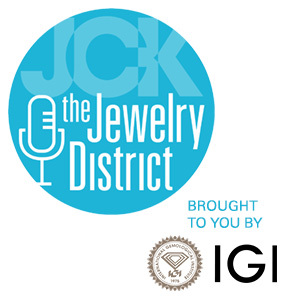
On this week’s episode, JCK editor-in-chief Victoria Gomelsky and news director Rob Bates discuss highlights from Watches and Wonders Geneva, including a Bremont relaunch and Rolex’s first new collection in 13 years. “Rolex has really thrown down the gauntlet” with its new Dynapulse escapement, Victoria reports. Next, the pair analyze the initial effect on the jewelry industry of the Trump administration’s tariff announcements and offer some perspective on what may lie ahead during a time of rapid change and continuing uncertainty.
Listen Now
Presenting sponsor: IGI (igi.org/education)
Sponsor: Nivoda (nivoda.com)
Episode Credits
Hosts: Rob Bates and Victoria Gomelsky
Producer and engineer: Natalie Chomet
Editor: Riley McCaskill
Plugs: @jckmagazine; igi.org/education; nivoda.com
Show Notes
01:26 News from Watches and Wonders
05:25 Rolex debuts Land-Dweller
09:58 Bremont’s new look
13:06 Talk of tariffs
21:04 J.K. Symanyck takeaways
Show Recap
News from Watches and Wonders
Victoria recaps the year’s biggest watch trade show, Watches and Wonders Geneva. It was a whirlwind of back-to-back appointments and events, including a Bulgari gala dinner to celebrate Aeterna, a new line in the brand’s Serpenti collection, on her first night in Switzerland.
Rob asks how Watches and Wonders compares to Baselworld, once the leading annual watch trade show. “It’s very different,” says Victoria. “It has taken on that role of replacing Baselworld, but it really can’t.”
Watches and Wonders began as Salon International de la Haute Horlogerie (SIHH) with a handful of high-end watchmakers that had peeled away from Baselworld as early as 1999, explains Victoria. Over the years, particularly since Baselworld’s collapse, it has grown exponentially and added prominent exhibitors like Rolex, Chopard, TAG Heuer, and Hublot.
But Geneva wasn’t built for all the traffic that arrives for the watch fair, which can mean a lengthy commute between downtown, where satellite events take place at hotels near the lake, and the show itself, held at the Palexpo convention center near the airport.
By contrast, the Basel convention center provided easy access by tram to the city. It’s not quite as convenient in Geneva, where you generally have to take a bus, she says.
What’s more, Basel’s enormous convention center had multiple halls located around a central plaza, so “you could discover a lot of things just walking between the halls,” says Victoria. While there is a dedicated area for independent brands inside Palexpo, Watches and Wonders doesn’t lend itself to exciting new finds as readily, in her opinion. “It is definitely more refined, but it just lacks that discovery element…. You kind of know what you’re getting.”
Rolex debuts Land-Dweller
The crowd at Watches and Wonders was abuzz over Rolex introducing its first new collection in 13 years, the Land-Dweller. These watches have an integrated bracelet that pays homage to historic pieces the brand produced in 1969 and 1974, and are available in different metals, including platinum and Everose, Rolex’s version of rose gold. (You can read JCK’s coverage here.) “It’s very handsome [and] quite slim,” says Victoria, though feelings are mixed on the dial’s honeycomb pattern.
Most of the hype around the Land-Dweller is about the mechanics rather than the look, says Victoria. The Land-Dweller features a new Dynapulse escapement that’s meant to be more efficient, robust, and precise than competitors, she says. “It replaces what was Rolex’s proprietary version of the traditional Swiss lever escapement.”
Vic says, “Rolex has really thrown down the gauntlet and said, ‘We are the ones to be trusted to create the most precise and accurate timekeepers’—they will run in perpetuity, essentially. For a company that has staked its reputation on incremental change—evolution, not revolution—this was pretty big news.”
An escapement is “a bit of an esoteric thing,” according to Rob, who was struck by the amount of press coverage it got. “Do fans care…and is this something that is considered a sales tool?” he asks. Some do, replies Victoria. “You’ve got your watch nerds out there, and they are perhaps the most passionate of all collectors,” she says. They can cite caliber numbers and millimeter distances between levers. “It’s mind-blowing,” she says. In fact, musician John Mayer, whom she interviewed last summer, is “certainly of that ilk.”
Victoria is curious to see whether Rolex will equip all its collections with the new escapement going forward. She notes that Rolex is a brand built on the incredible sense of trust consumers have in it, and a lot of that trust “boils down to what’s ticking inside.”
Bremont’s new look
Also on hand at Watches and Wonders was the U.K. brand Bremont, which has relaunched with new investors, including American billionaire Bill Ackman. For anyone unfamiliar with Bremont, Victoria shares some background: It was founded by brothers Nick and Giles English in Henley-on-Thames in 2002 with the goal of revitalizing British watchmaking and amassed a cult following for its “adventurous sensibility” and “cool ambassadors,” she says.
Ackman himself was at the fair and walked Victoria through the brand’s new collection, which she “quite liked.” The piece that stood out most was a jump hour model, “basically a model that doesn’t have a traditional watch face, it has a metal face with an aperture at the top where these numbers will appear to indicate the time,” she says.
Talk of tariffs
News of President Trump’s tariffs broke while Victoria was in Geneva, setting off widespread apprehension over a possible 30% rate on most Swiss goods (though it was later reduced to 10%).
Rob says the announcement of what Trump calls “reciprocal tariffs” triggered confusion and worry in the jewelry industry, particularly because the plan would have slapped diamond producers such as Lesotho and Botswana with heavy tariffs, and India with a 26% duty.
The formula used to calculate the tariffs was based on each country’s trade deficit with the United States divided by its imports to the U.S., Rob says. Obviously, small nations like Botswana and Lesotho are going to run a trade deficit with the much larger, richer United States. “It’s hard to imagine any kind of scenario where we get our trade deficit to zero with those countries,” he says.
Shortly after the tariffs were announced, they were put on hold for 90 days. At press time, they were at 10% for all countries except for China, which has a 145% tariff. That’s “still historically extremely high…and it still could mean certain prices will go up,” says Rob.
The chaotic week triggered memories of the COVID pandemic for Rob. “It was so crazy and stressful,” he says. “It was the kind of situation where you really had no control over it, but you felt you had to do something because it was your business. People did start talking about reorienting their supply chains, but the problem is, how can you do long-term planning when the situation is so fluid?”
Rob says that while he supports buying American-made products and boosting American workers, “this was very, very stressful…. A lot of the business was frozen while people tried to figure out what was going on. There were a lot of orders that were rusheed to get ahead of the tariffs…just a lot of general panic, and I think people weren’t sure what to do.”
Victoria asks how people can manage the situation. Rob says there are classic tariff mitigation techniques, such as separating the cost of the item into various segments because tariff rates for service and product can differ. Ultimately, however, Rob and Victoria agree that there’s no foolproof strategy.
Rob points out that for Customs purposes, the country of origin for diamonds and gemstones is determined based on where they were cut, not where they were mined. This is bad news for Botswana, which has been working to increase local stone cutting and is already struggling with a weak market for natural diamonds. “Had these tariffs gone into effect as they were planned, a Botswana diamond cut in India would have gotten a lesser tariff than a Botswana diamond cut in Botswana,” Rob explains.
In a lot of ways, it was a lost week for business because people spent their time talking about tariffs and scrambling to figure things out, he says.
On a more encouraging note, Rob reflects on past crises for the jewelry industry during his and Vic’s years covering the business, and he concludes that the industry generally comes out stronger. “That said, it’s not a lot of fun living through a crisis,” he says. “This week it really felt like a crisis…. We are still going to deal with the repercussions because a lot of people import from China.”
J.K. Symanyck takeaways
Victoria asks for Rob’s thoughts on their recent conversation with J.K. Symancyk, CEO of Signet. Rob praises his confidence, friendly demeanor, and straightforward answers to their questions, and says he likes Symancyk’s idea of concentrating on Signet’s “big three” brands (Zales, Kay, and Jared). But Rob wonders what it will mean in the long term for the company’s other brands, including Blue Nile, James Allen, and Diamonds Direct. “They all have parts in his new lineup,” he says. “But long-term, will there be some kind of rationalization of all the brands?”
J.K. struck Rob as a big-picture thinker with a clear vision for the company’s future. Given Signet’s reliance on imports, it faces a challenging economy, Rob adds.
Victoria agrees about J.K.’s candor and likes that he brings experience and perspective from working in numerous other industries to his position at Signet. “He didn’t seem the slightest bit concerned about navigating a totally new category that does have some essential differences from the other kinds of categories he’s specialized in,” she says. “I’m keen to see where he goes.” She adds that she’s looking forward to meeting him at JCK Las Vegas.
Any views expressed in this podcast do not reflect the opinion of JCK, its management, or its advertisers.
- Subscribe to the JCK News Daily
- Subscribe to the JCK Special Report
- Follow JCK on Instagram: @jckmagazine
- Follow JCK on X: @jckmagazine
- Follow JCK on Facebook: @jckmagazine




